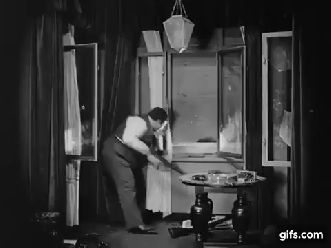Dr. Mabuse, Der Spieler, is amazing, and weirdly riveting for a movie that’s nearly 100 years old, and when the full four hours finally ran their course I thought of a night when I was fifteen and my brother and his girlfriend, who were I guess seventeen or eighteen, snuck me into a 7 p.m. showing of The Departed. As we were walking to the car afterward, around 10 p.m., everybody marveled at how late it was. The movie’d been so gripping and propulsive, none of us would’ve guessed it’d been more than a couple hours. I think this was probably the first time I ever thought about a story’s pacing. I was marveling, too, at The Departed‘s complexity, which only became clear as I was turning it over in my head later on and, struggling to write my own short stories in that same sort of crime-y vein, started feeling inspired and despondent about how The Departed had managed to be super exciting, and to zip without a hitch through its nearly-three hour runtime, and yet was also, somehow, perfectly coherent, and easy to follow, despite its flurry of intersecting sub-plots, its big cast of characters, the double- and triple-crosses among those many characters, et cetera. I’m probably not so enamored of The Departed now, ten years later, but I’ve got a soft spot for how much of an impression it made on me back then.
The Gambler, the first in a trilogy of Mabuse movies, is about a con artist (the titular Doktor, played by Rudolf Klein-Rogge) who manipulates the stock market into his corner and coerces aristocrats into gambling way their fortunes (which end up in his pocket). He’s basically the boss of a crime syndicate whose proclivities include kidnapping and blackmail and forgery and, by the end of the movie, murder.

Rudolf Klein-Rogge as Dr. Mabuse might have the most subtly emotive face of any silent film star I’ve seen so far, and Mabuse might be one of my all-time favorite film characters. Klein-Rogge and the director here, Fritz Lang, have apparently worked pretty amicably on several films, even after the wife of the actor ran off with the director in the early 1920s. (Klein-Rogge also apparently had an uncredited role as the knife-wielding not-quite-murderer in The Cabinet of Dr. Caligari.)
You can tell from the first act that there’s something distinct about the look of each scene, something particularly…Langian? It took me a while to figure out what it is but I think I finally got it: parallel lines. Vertical, horizontal, diagonal – sometimes all in one shot. Striped wallpaper, the camera’s emphasis of a tall candelabra in the background, the formation of tiles. A general fuckery about the geometric layout and spacial depth if each shot. There’s also some impressive camera work that I feel like I’m noticing on an intuitive level but can’t really articulate.
Lang is obviously a master of what he’s doing and it’s humbling for me to try to talk about it fluently because you can see, in 2016, that this movie is ahead of its time simply by merit of the fact that it isn’t boring, even with a four-hour runtime, and yet I can’t put my finger on why it works so well. But maybe that’s one of the staples of a master’s work, is that you can’t see what they’re doing behind the curtain.








Cannot say I was as excited about Dr. Mabuse as you were but there was a lot pointing forward. The second half was far better than the first half.
LikeLike